

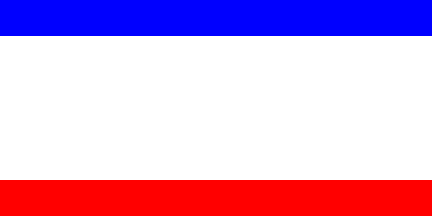
KRIM |
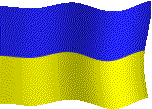
UKRAINE UKRAINA |
4 SEPTEMBER:
Around Crimea in a Red Ziguli
 CRIMEAN
COAST: ALUSHTA & YALTA We set off early, with
Aleksandra coming with us. Yevgeny’s dear old Ziguli sped its way
southwards and soon found ourselves along a pine-lined highway across the
Crimean Range. Along this highway is the famous trolleybus line from
Simferopol to Yalta – the world’s longest, they say. We passed a
few and they were full of holidaymakers rushing to the coast.
CRIMEAN
COAST: ALUSHTA & YALTA We set off early, with
Aleksandra coming with us. Yevgeny’s dear old Ziguli sped its way
southwards and soon found ourselves along a pine-lined highway across the
Crimean Range. Along this highway is the famous trolleybus line from
Simferopol to Yalta – the world’s longest, they say. We passed a
few and they were full of holidaymakers rushing to the coast.
And then, we caught sight of the Black Sea. Black Sea ! It isn’t black, but simply dark blue. What a reunion ! The last time I touched its shores was in 1995, when I was on the southern side of it, in Turkey. We drove through the seaside resorts – Alushta, Hurzuf, and then Yalta. Palm trees, sandy beaches, babes in bikinis, youths showing off their six pecks, tacky amusement parks, ice cream kiosks, game machines and more. Could have been St Tropez, Nice and Monte Carlo. We strolled around Yalta’s windy seaside promenade.
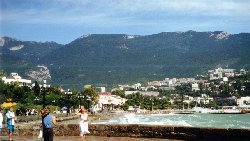 The beaches of Yalta: A Ukrainian Monroe taking a picture ?
The beaches of Yalta: A Ukrainian Monroe taking a picture ?
A replica of a Greek boat reminded one of the city’s ancient past, when Greek sailors and traders settled on this coast, building cities that exported to the old country wheat grown by the Scythians, a nomadic tribe lost in the midst of history, and in return, selling to the Scythians, golden jewelry that are still being found in the ancient burial mounds scattered across the plains and steppes of Ukraine.
The Greeks were long gone, also victims of Stalin’s whims and fancies. With their close links to Athens and the Diaspora, the ancient community was uprooted and deported to the deserts of Central Asia, the only remnants of their presence being their glorious wines, which are still being eagerly sought by the consumers in Moscow, St Petersburg, Kyiv and Almaty.
Civilisations, empires and khanates came and went. Tsar Alexander II made Crimea fashionable by building a holiday palace in Livadia, one of Yalta’s suburbs. The nobles and railway tycoons of Russia followed, and their palaces dotted the beautiful shoreline of Crimea today.
But it was Lenin who turned Crimea into a mass playground. The statue
of Lenin stood in Prymorsky, a beautiful tropical park along the beach.
On it is a plaque with Lenin’s 1920 decree, “On the Use of the Crimea for
the Medical Treatment of the Working People”. Since then, workers
sanatorium and resorts were built along the coast, and generations of Soviet
citizens have come to Yalta to enjoy themselves, and to forget the rigidities
and stifling lifestyle of a totalitarian system. Just ask any FSU
friend of yours. Many people have fond memories of family holidays
by the Black Sea in an era when foreign travel was all but almost impossible.
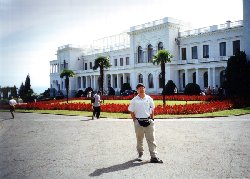 |
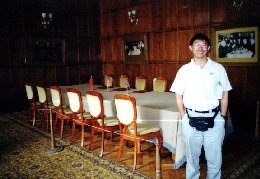 |
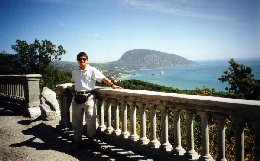 |
|
In front of the Livadia Palace |
One of the conference table at Livadia Palace - see the flags of USSR, UK and USA | View of the Crimean coast from a terrace at Livadia Palace |
We visited the Livadia Palace, where Stalin, Roosevelt and Churchill
met in 1945 to carve Europe into spheres of influence. Here the fate
of Eastern Europe was determined for the next almost 50 years, and even
today, many of these nations remain in economic and political limbo, crushed
by the burden of history. In a few days’ time, the summit of the
Baltic and Black Sea States would be held here, perhaps in the hope that
they could exorcise the ghosts of communism and ethnic conflict.
According to the press, personality crashes and horse-trading had already
began among the leaders of these countries. Polish President Aleksander
Kwasniewski threatened not to go to Yalta if Belarus’ Lukashenko were
to attend, and Lukashenko quarreled with Ukraine’s President Kuchma over
the phone. It seems that the palace if not the whole region is still
haunted by the spectre of hatred…
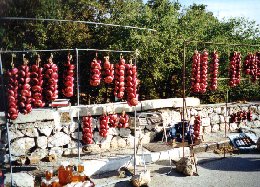 Red garlic: a popular snack in Yalta region - need it against traveller-hunting
vampires ?
Red garlic: a popular snack in Yalta region - need it against traveller-hunting
vampires ?
If the talk of ghosts have not already put on your nerves, visit the
exhibit on Nicholas II and his unhappy family – the last Tsar and his family
were all massacred by the Bolsheviks in 1918 at Yekaterinburg - on the
second floor of the palace. I walked around the beautifully decorated
rooms, with photos of the Romanovs’ happier times spent at Livadia and
elsewhere. The stiff-looking Tsar and his beautiful empress, who
was rumoured (perhaps wrongfully) to be linked romantically to a mad monk-mystic
Rasputin. The cute little Tsarkevich (crown prince). Pretty
Princess Anatashia. Riding a horse. On the beach. Reading a
book. Attending parties. In a few years’ time, they would be
gone, devoured by the monster of the Revolution.
Old Nobles & New Ones
FOROS We continued our drive westwards, passing Swallow’s Nest, a castle built by a German baron and oil magnate. Perched on a steep cliff-side, the fairy tale castle looked as though it had been transplanted from Rhineland or the Bavarian Alps.
The Alupka Palace, built by Count Vorontsov, governor-general of Novorossiya, or New Russia Territory which stretched from Odessa to the Crimea, was next. Educated in England and an admirer of all things British, the immensely wealthy nobleman – enriched by dodgy property deals in the Crimea and Odessa – built a Scottish castle with a pseudo Indian Moghul façade facing the Black Sea. And he certainly loved the beautiful Baroque garden and tropical palms. His exotic taste was certainly matched by his wife’s sense of adventure. The noble lady had a well known passionate affair with Alexander Pushkin, Russia’s greatest poet and a dashing romantic figure, whose grandfather was an Ethiopian general.
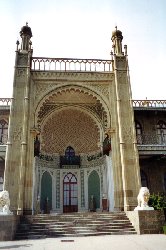 In India ? No, that's Alupka Palace built by Count Vorontsov
In India ? No, that's Alupka Palace built by Count Vorontsov
We passed Foros, the infamous cove where in 1991 Mikhail Gorbachev was put under house arrest at the presidential villa, while hardline figures in the Kremlin staged a coup d’etat, attempting to turn back the clock of reform. Of course, we all knew that they failed, but the final trigger on the Union was pulled, which collapsed like a pack of cards. Today, the villa is well hidden behind pine trees and rocks, and with new owners – president of the Republic of Ukraine, Leonid Kuchma. On the breathtaking cliffs above is the Foros Church, a pretty little structure built by a tea tycoon to thank providential intervention for supposedly stopping a runway horse which carried his daughter to this spot. We saw a mass being conducted within, with the Orthodox dispensing incense and the devoted singing in chorus. Perhaps they were praying for the redemption of the sins of corrupt leaders who once lived and still live in the executive villa below.
Driving around in Ukraine, especially Crimea, is a challenge.
Police of the State Outdoor Inspection Directorate, abbreviated GAI in
Ukrainian, stood at every corner, ever ready to stop vehicles at the flimsiest
of excuses, so as to supplement their meagre income. We were stopped
once, near Alupka, where Yevgeny (and I presume, by the eventual transfer
of financial burden, me) paid a fine of UAH 17 (US$3.40), supposedly because
his steering wheel was loose. No wonder locals relate GAI to another
similar sounding phase in the Russian language, meaning “to take” (money).
Vodka Party at Sevastopol
SEVASTOPOL Before
long, we reached Sevastopol, the ancient Greek trading port, the city where
Christianity first reached Lands of the Rus, site of the famous Crimean
War siege, WWII Hero City, and HQ of the Black Sea Fleet. With a
long list of historical credentials, it is no wonder that Sevastopol has
a special place in the hearts of the Eastern Slavic successor nations of
the Rus - Russia, Ukraine and Belarus. Given its great military significance
as the guardian of the CIS Black Sea Coast, the city has long been a closed
city to the outside world. During the Soviet days, even Soviet citizens
need special permission to visit the city. A few years ago, I would
have been stopped by military police on the city’s boundaries. Today,
one can just take any bus into the city, and take photos of the many warships
and submarines in the harbour. Even then, Yevgeny reminded me about
my passport, and said that police might still stop us for an identification
check.
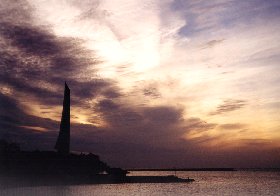 Sunset in Sevastopol: Trouble in the horizon ?
Sunset in Sevastopol: Trouble in the horizon ?
We strolled along the seaside promenade of this naval city. Young, crew cut marines and sailors were having nights off, happily exploring the local bars. Lovers embraced in the dying afternoon light. Elderly veterans were playing chess in their smart jackets with military medals of a braver, prouder era. A band entertained a bored audience in the park. A lonely column with the statue of a falcon stood in the harbour, commemorating the brave sailors who sunk the ships to block the Anglo-French armies from entering the harbour. A loudspeaker blared out loud military music. Merely less than 100km away from carefree, fun-loving Yalta, Sevastopol is a fading symbol of what’s left of the military might of the old Soviet Union. A sense of national pride and memories of past glories still pervades this city. To the Russian-speaking citizens of Sevastopol, Sevastopol was built by the Russians and the fleet should rightfully be Russian. With the independence of Ukraine, the ownership of this city and the fleet has become a subject of intense dispute. Commentators thought that war might break out between the two nations. The city’s nationalistic council even declared Sevastopol a district of the City of Moscow at one stage. Eventually, both sides compromised, with Ukraine leasing the port to Russia and gaining a few rusty warships and submarines in return. With both countries virtually bankrupt, none is in a position to start a war. Status quo seems a logical conclusion for the time being.
“It’s time to visit our friends in Chersonesus,” Yevgeny prompted us. Chersonesus, the ancient Greek city, was founded in 422 BC. Located 3 km to the southeast of Sevastopol, it is an important archaeological site, where archaeologists are still uncovering artifacts on a regular basis. We drove through Sevastopol’s run-down suburbs and finally entered the grounds of the archaeological park, located just next to a naval camp. We stood briefly at a huge bell, just in time to watch the sunset. It was pure exhilaration! The orange lights lit up the horizons, and slowly descended, until they merged with the purplish ocean. I could imagine a bored Chersonesus Greek youth standing here two thousand years ago, wondering when the next shipment of Mykonos olives and Cretan wines would arrive, together with the latest Athenian gossips. Or whether new settlers would come, to defend this rich city-state in its latest skirmish with the inland barbarians who in better times were allies and trading partners. Or perhaps newcomers from the Old Country were not welcomed after all, for most were snobby, boastful and arrogant, and were contemptuous of their isolated ethnic cousins who intermarried freely with barbarian women and picked up strange accents.
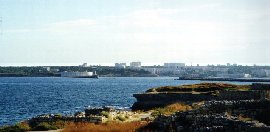 Gates to the harbour of Sevastopol: A view from Chersonesus - How many
have died to defend this strategic harbour ?
Gates to the harbour of Sevastopol: A view from Chersonesus - How many
have died to defend this strategic harbour ?
We proceeded to the house of Galina, assistant director of the archaeological park. The summer expedition has ended, and the archaeological team was now having their farewell party, before returning to their respective homes in Moscow, Kyiv and Sevastopol. Yevgeny knew them well, having brought many visitors here. This cheerful, friendly lot welcomed us, and invited us to join them at the table. Fine Crimean wines were passed around, together with vodka and assorted dishes of aubergine and barbecue meat. These were a remarkable group of people. Out of eleven, only three were full-time archaeologists. The rest came from a wide spectrum of professions, ranging from medical doctors, geophysicists and naval scientists. They were all linked by one common interest – their love for history and archaeology.
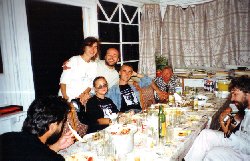 As
a travel junkie, I often envy those whose employers were enlightened enough
to allow their staff take extensive vacations. I wondered, naively,
how these people managed to get away for three months every summer, with
obviously little financial reward. Of course, they could, as Yevgeny
explained. In an era of the bankrupt state and economic instability,
most research institutes and companies of the FSU simply find it hard to
pay their employees. If a staff requests for a period of payless
vacation, employers cannot but feel relieved that the money burden has
been slightly lessened. For the individual, the opportunity cost
is minimal, for it allows them to pursue their interests while living on
free premises and food at the archaeological park, which is certainly more
worthwhile than pretending to work for an uncertain paycheck.
As
a travel junkie, I often envy those whose employers were enlightened enough
to allow their staff take extensive vacations. I wondered, naively,
how these people managed to get away for three months every summer, with
obviously little financial reward. Of course, they could, as Yevgeny
explained. In an era of the bankrupt state and economic instability,
most research institutes and companies of the FSU simply find it hard to
pay their employees. If a staff requests for a period of payless
vacation, employers cannot but feel relieved that the money burden has
been slightly lessened. For the individual, the opportunity cost
is minimal, for it allows them to pursue their interests while living on
free premises and food at the archaeological park, which is certainly more
worthwhile than pretending to work for an uncertain paycheck.
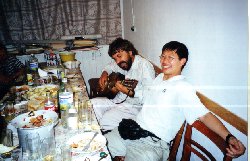 Endless
drinking, toasting and speeches. A toast to eternal friendship!
To Crimea for all the fine wines! To Russia, Ukraine, and yes, to
Singapore! To women! To those in love, and those out of love!
To happiness, good health and luck! The list went on and on.
Dark haired Dimitriy played his guitar and Oleg with his beard a la Alexander
Solzhenitsyn sang loudly. The rest joined in. Young Pioneer
camping songs, folk ballads, Revolutionary songs, White Army tunes – the
crowd was obviously enjoying themselves. Yevgeny, in his usual jester-like
self, even performed a few funny tricks with fire and paper – he could
well burn down the house! No worry- everything’s under control.
It was a pity I couldn’t understand Russian. While I have clearly
enjoyed it all, I also felt that I have missed a lot of the fun.
Even then, I was touched by their hospitality, and was a little tipsy at
the end of it. It’s time to take a break, Yevgeny said, for we have
a tight schedule the next day.
Endless
drinking, toasting and speeches. A toast to eternal friendship!
To Crimea for all the fine wines! To Russia, Ukraine, and yes, to
Singapore! To women! To those in love, and those out of love!
To happiness, good health and luck! The list went on and on.
Dark haired Dimitriy played his guitar and Oleg with his beard a la Alexander
Solzhenitsyn sang loudly. The rest joined in. Young Pioneer
camping songs, folk ballads, Revolutionary songs, White Army tunes – the
crowd was obviously enjoying themselves. Yevgeny, in his usual jester-like
self, even performed a few funny tricks with fire and paper – he could
well burn down the house! No worry- everything’s under control.
It was a pity I couldn’t understand Russian. While I have clearly
enjoyed it all, I also felt that I have missed a lot of the fun.
Even then, I was touched by their hospitality, and was a little tipsy at
the end of it. It’s time to take a break, Yevgeny said, for we have
a tight schedule the next day.
Before retiring to our little hut, Yevgeny proposed a walk around the
archaeological park – in the dark! He led the way, with semi-drunk
me following closely behind. We walked through the ruins slowly,
making sure we don’t fall into the many holes scattered throughout, or
worst, off the cliffside. The lights of Sevastopol were blinking
at us. I could make out the Corinthian columns which represent the
northern reach of the Greek civilisation. It was a most unusual experience.
The cold sea breeze did some good in keeping me alert, or at least, pseudo-alert.
In more sober circumstances, the conservative, risk-adverse accounting-trained
banker in me wouldn’t have contemplated a walk along the cliffside ruins
in almost total darkness.
![]() 5
SEPTEMBER: CRIMEA: SEVASTOPOL, BALACLAVA & MANGUP KALE: The Day I Became
A Spy
5
SEPTEMBER: CRIMEA: SEVASTOPOL, BALACLAVA & MANGUP KALE: The Day I Became
A Spy
| RETURN TO FROM THE BALTIC TO THE BLACK SEA HOMEPAGE |